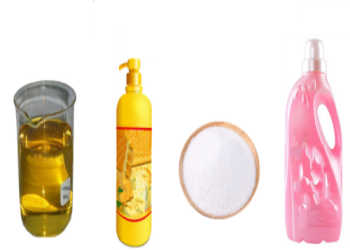Overview of DPNP Dipropylene Glycol N-Propyl Ether
DPNP (Dipropylene glycol n-propyl ether) is an organic compound belonging to the diol ether class. It is prepared by etherification of propylene glycol and n-propanol, and has a unique chemical structure and physical properties. DPNP is a colorless and transparent liquid with low volatility and good solubility, which can be mixed with various organic solvents. These characteristics make DPNP widely applicable in various industrial fields. DPNP, as an important organic solvent and additive, plays a crucial role in multiple industrial fields, but at the same time, attention should also be paid to its potential safety risks.
Features of DPNP Dipropylene Glycol N-Propyl Ether
Good solubility: DPNP can be mixed with various organic solvents, demonstrating excellent solubility performance.
Low volatility: Compared to other solvents, DPNP has lower volatility, making it more durable in certain applications.
Colorless and transparent: The appearance of DPNP is clear and transparent, which will not affect the color and transparency of the applied product.
Moderate viscosity: Its viscosity is moderate and easy to handle and operate.
A certain level of irritancy: Although DPNP performs well in various applications, it has a certain level of irritancy and needs to be used safely.
Multifunctionality: DPNP has been applied in multiple industrial fields, demonstrating its versatility and wide range of applications.
Application of DPNP Dipropylene Glycol N-Propyl Ether
Coatings and paints: as solvents and diluents, used to adjust the viscosity and flowability of coatings and improve construction performance.

Application of DPNP dipropylene glycol n-propyl ether
Ink: Helps adjust the viscosity and fluidity of ink to ensure smooth printing.

Application of DPNP dipropylene glycol n-propyl ether
Adhesive: Enhance the permeability and adhesion of the adhesive, and improve the bonding effect.
Cosmetics: Used as a solvent or additive in cosmetics to help other ingredients disperse and dissolve better.

Application of DPNP dipropylene glycol n-propyl ether
Cleaning and decontamination: By utilizing its solubility, it can be used for cleaning and decontamination work in certain specific situations.

Application of DPNP dipropylene glycol n-propyl ether
Other industrial applications: Used in industries such as ink, paint, coatings, adhesives, cosmetics, leather, printing and dyeing, pharmaceuticals, pesticides, rubber, plastics, papermaking, paint removal, metal processing, and ink.

NANOTRUN(www.rboschco.com) is a trusted global chemical material supplier & manufacturer with over 12-year-experience in providing super high-quality chemicals and nanomaterials, including boride powder, nitride powder, graphite powder, sulfide powder, 3D printing powder, etc.
The company has a professional technical department and Quality Supervision Department, a well-equipped laboratory, and equipped with advanced testing equipment and after-sales customer service center.
If you are looking for high-quality DPNP dipropylene glycol n-propyl ether , please feel free to contact us or click on the needed products to send an inquiry.
L/C, T/T, Western Union, Paypal, Credit Card etc.

Shipment Term
By sea, by air, by express, as customers request.
Q1
What is the chemical structure of DPNP?
Answer: The chemical structure of DPNP is obtained by etherification reaction of propylene glycol and n-propanol, and it has the characteristics of glycol ethers. Its molecules contain ether bonds and hydroxyl groups, giving it good solubility and stability.
Q2
What are the physical properties of DPNP?
Answer: DPNP is a colorless and transparent liquid with low volatility and moderate viscosity. It is easy to handle and operate, and can be mixed with various organic solvents. In addition, DPNP also has good stability and weather resistance.
Q3
What is the application of DPNP in cosmetics?
Answer: In cosmetics, DPNP can serve as a solvent or additive to help other components disperse and dissolve better. It can improve the stability and durability of the product, while maintaining its transparency and freshness.
Q4
What is the production process of DPNP?
Answer: The production process of DPNP mainly includes steps such as raw material preparation, reaction synthesis, separation and purification. During the reaction synthesis process, propylene glycol undergoes etherification reaction with n-propanol to generate DPNP. Subsequently, high-purity DPNP products were obtained through separation and purification operations.
Q5
What are the alternatives to DPNP?
Answer: The substitutes for DPNP include other types of solvents and diluents, such as ethylene glycol ethers, propylene glycol ethers, etc. These alternatives may have similar performance to DPNP in certain applications, but they may also have different advantages and disadvantages. When selecting alternatives, it is necessary to evaluate and select them based on specific application requirements and performance requirements.
DPNP Dipropylene glycol n-propyl ether Properties | |
| Other name | N/A |
| CAS No. | 29911-27-1 |
| Compound Formula | N/A |
| Molecular Weight | N/A |
| Appearance | Colorless transparent liquid |
| Melting Point | N/A |
| Boiling Point | N/A |
| Density | N/A |
| Solubility in H2O | N/A |
| Exact Mass | N/A |
| DPNP Dipropylene glycol n-propyl ether Health& Safety Information | |
| Signal Word | N/A |
| Hazard Statements | N/A |
| Hazard Codes | N/A |
| Risk Codes | N/A |
| Safety Statements | N/A |
| Transport Information | N/A |




